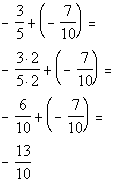

-15 + 7
The difference between 15 and 7 is 8 and the sign of 15 (the larger
absolute value) is -, that is how we get the answer of -8.
![]()

*Add the numerators and write over common denominator 10
3.2 + (-1.3) + (- 4.1)

|- 4 + (-3) + 2|

1/2
-20
-(- 4)
![]()

Last revised on July 24, 2011 by Kim Seward.
All contents copyright (C) 2001 - 2011, WTAMU and Kim Seward.
All rights reserved.